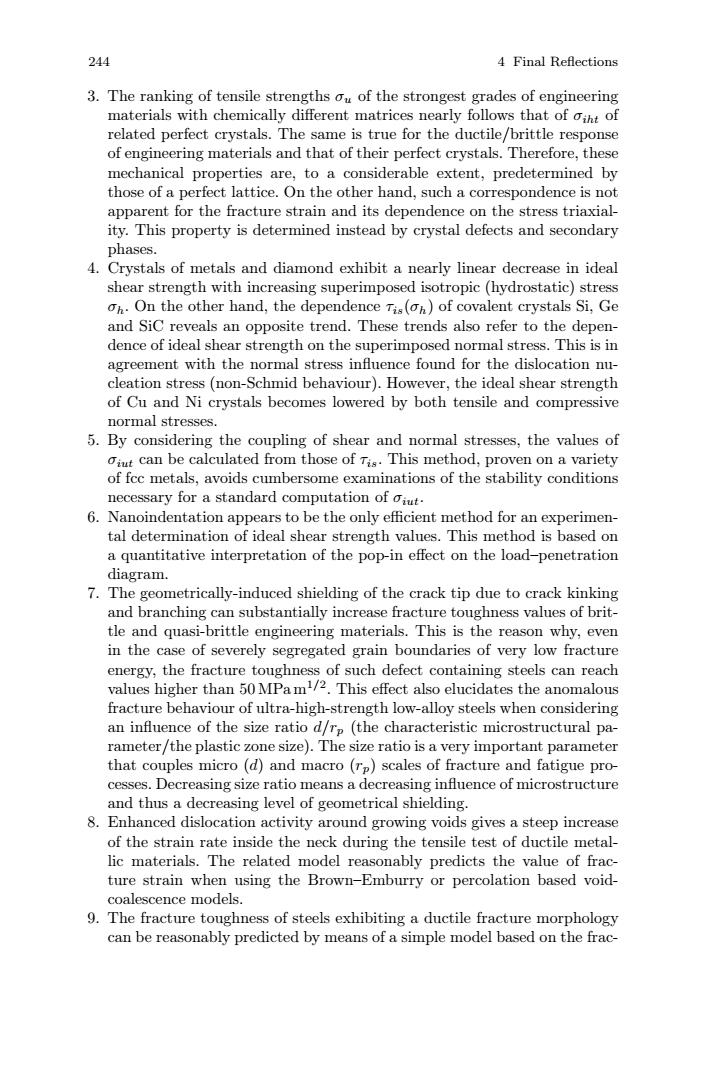正在加载图片...

244 4 Final Refections 3.The ranking of tensile strengths ou of the strongest grades of engineering materials with chemically different matrices nearly follows that of oiht of related perfect crystals.The same is true for the ductile/brittle response of engineering materials and that of their perfect crystals.Therefore,these mechanical properties are,to a considerable extent,predetermined by those of a perfect lattice.On the other hand,such a correspondence is not apparent for the fracture strain and its dependence on the stress triaxial- ity.This property is determined instead by crystal defects and secondary phases. 4.Crystals of metals and diamond exhibit a nearly linear decrease in ideal shear strength with increasing superimposed isotropic (hydrostatic)stress oh.On the other hand,the dependence Tis(on)of covalent crystals Si,Ge and SiC reveals an opposite trend.These trends also refer to the depen- dence of ideal shear strength on the superimposed normal stress.This is in agreement with the normal stress influence found for the dislocation nu- cleation stress(non-Schmid behaviour).However,the ideal shear strength of Cu and Ni crystals becomes lowered by both tensile and compressive normal stresses. 5.By considering the coupling of shear and normal stresses,the values of oiut can be calculated from those ofTi This method,proven on a variety of fcc metals,avoids cumbersome examinations of the stability conditions necessary for a standard computation of oiut. 6.Nanoindentation appears to be the only efficient method for an experimen- tal determination of ideal shear strength values.This method is based on a quantitative interpretation of the pop-in effect on the load-penetration diagram 7.The geometrically-induced shielding of the crack tip due to crack kinking and branching can substantially increase fracture toughness values of brit- tle and quasi-brittle engineering materials.This is the reason why,even in the case of severely segregated grain boundaries of very low fracture energy,the fracture toughness of such defect containing steels can reach values higher than 50 MPam1/2.This effect also elucidates the anomalous fracture behaviour of ultra-high-strength low-alloy steels when considering an influence of the size ratio d/rp (the characteristic microstructural pa- rameter/the plastic zone size).The size ratio is a very important parameter that couples micro(d)and macro(rp)scales of fracture and fatigue pro- cesses.Decreasing size ratio means a decreasing influence of microstructure and thus a decreasing level of geometrical shielding. 8.Enhanced dislocation activity around growing voids gives a steep increase of the strain rate inside the neck during the tensile test of ductile metal- lic materials.The related model reasonably predicts the value of frac- ture strain when using the Brown-Emburry or percolation based void- coalescence models. 9.The fracture toughness of steels exhibiting a ductile fracture morphology can be reasonably predicted by means of a simple model based on the frac-244 4 Final Reflections 3. The ranking of tensile strengths σu of the strongest grades of engineering materials with chemically different matrices nearly follows that of σiht of related perfect crystals. The same is true for the ductile/brittle response of engineering materials and that of their perfect crystals. Therefore, these mechanical properties are, to a considerable extent, predetermined by those of a perfect lattice. On the other hand, such a correspondence is not apparent for the fracture strain and its dependence on the stress triaxiality. This property is determined instead by crystal defects and secondary phases. 4. Crystals of metals and diamond exhibit a nearly linear decrease in ideal shear strength with increasing superimposed isotropic (hydrostatic) stress σh. On the other hand, the dependence τis(σh) of covalent crystals Si, Ge and SiC reveals an opposite trend. These trends also refer to the dependence of ideal shear strength on the superimposed normal stress. This is in agreement with the normal stress influence found for the dislocation nucleation stress (non-Schmid behaviour). However, the ideal shear strength of Cu and Ni crystals becomes lowered by both tensile and compressive normal stresses. 5. By considering the coupling of shear and normal stresses, the values of σiut can be calculated from those of τis. This method, proven on a variety of fcc metals, avoids cumbersome examinations of the stability conditions necessary for a standard computation of σiut. 6. Nanoindentation appears to be the only efficient method for an experimental determination of ideal shear strength values. This method is based on a quantitative interpretation of the pop-in effect on the load–penetration diagram. 7. The geometrically-induced shielding of the crack tip due to crack kinking and branching can substantially increase fracture toughness values of brittle and quasi-brittle engineering materials. This is the reason why, even in the case of severely segregated grain boundaries of very low fracture energy, the fracture toughness of such defect containing steels can reach values higher than 50 MPa m1/2. This effect also elucidates the anomalous fracture behaviour of ultra-high-strength low-alloy steels when considering an influence of the size ratio d/rp (the characteristic microstructural parameter/the plastic zone size). The size ratio is a very important parameter that couples micro (d) and macro (rp) scales of fracture and fatigue processes. Decreasing size ratio means a decreasing influence of microstructure and thus a decreasing level of geometrical shielding. 8. Enhanced dislocation activity around growing voids gives a steep increase of the strain rate inside the neck during the tensile test of ductile metallic materials. The related model reasonably predicts the value of fracture strain when using the Brown–Emburry or percolation based voidcoalescence models. 9. The fracture toughness of steels exhibiting a ductile fracture morphology can be reasonably predicted by means of a simple model based on the frac-